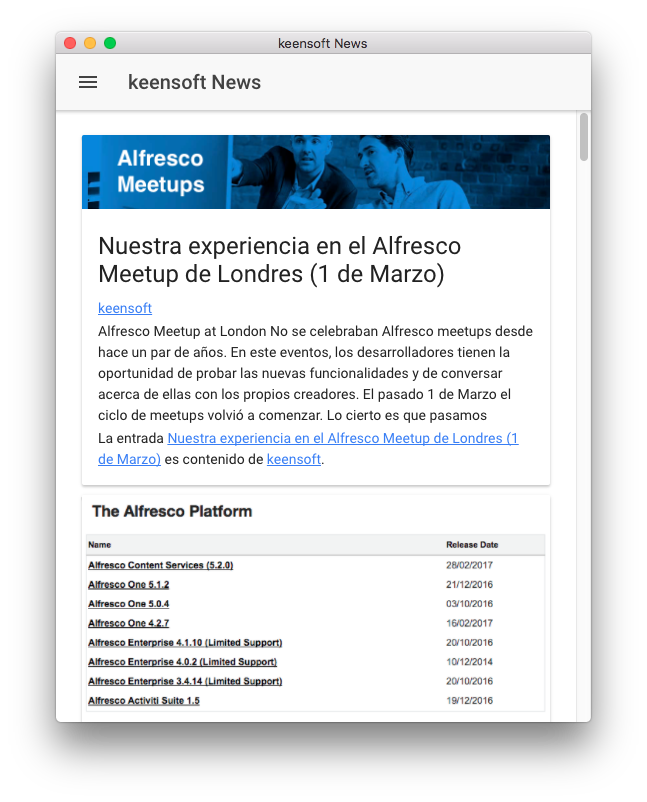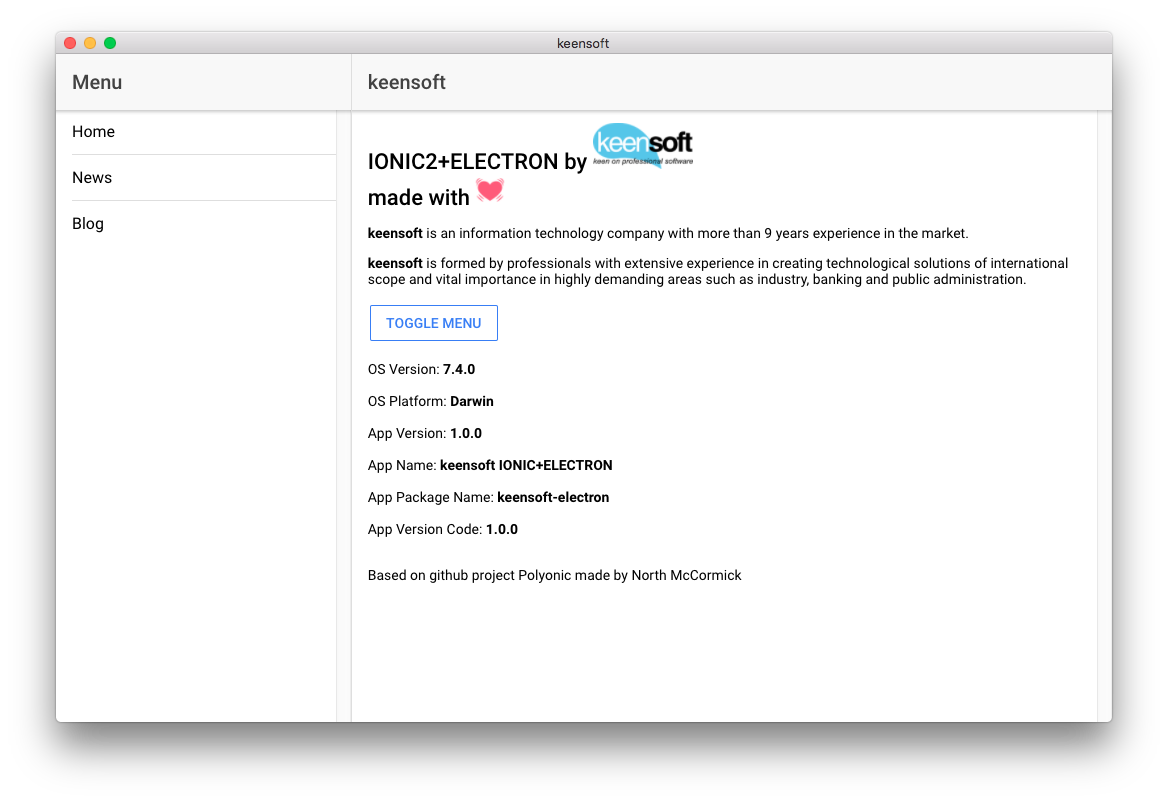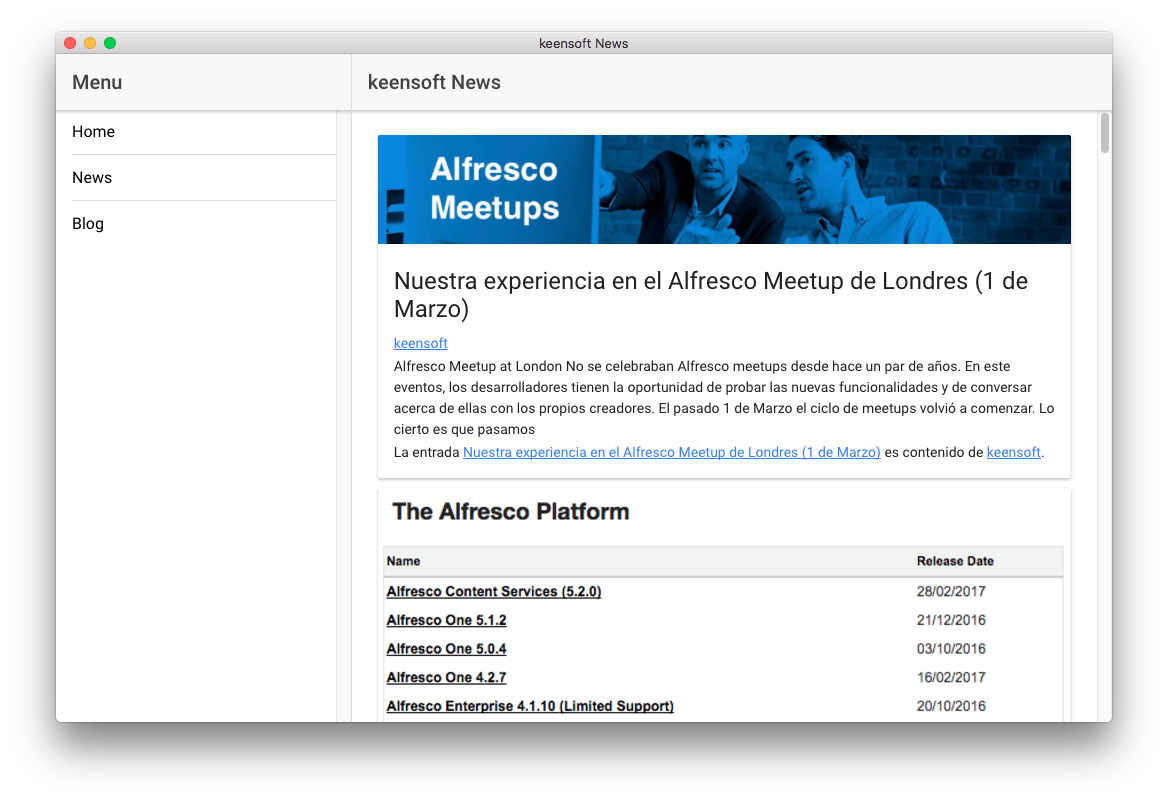App connect with 2 feed sources and display content. User can open external native window to view complete post.
App uses IONIC split-pane, doing responsive layout!

Now using the latest Ionic 2.2.0 release 🎉
This was created from Paul Sutherland's Polyonic project, but has since merged off into its own codebase.
An Electron Ionic application shell for creating Web Apps, Progressive Mobile Web Apps, Native Mobile Apps and Desktop Apps.
This project combines the Electron Framework with Ionic 2 and provides a starter for building out an app that can run on either the desktop (macOS, Windows and Linux), a browser or mobile devices (iOS, Android and Windows Phone). You can use this application to build and run on one or even all of these platforms.
Polyonic only makes minimal changes to your Ionic project. We add a couple of files (they are ignored on mobile platforms, so there's no extra bulk), update a setting, and ask you to put your ionic project inside of the polyonic shell.
Your development for mobile stays the same, and we provide a few extra commands and a way to kickstart the desktop version of your app!
Here's what it looks like side by side with your app in Cordova:
The second piece to these projects is Electrolyte, my shim for Cordova plugins so that the native features available on desktop and mobile can work with minimal changes (if any) to your codebase.
-
Clone this repo
-
Run
npm install -
Run
npm quickstart
-
Clone this repo
-
Run
npm install -
Overwrite the contents of the 'src' directory with the contents in the root directory of your ionic app
-
Run
npm installinside the 'src' directory to get your Ionic project node modules if you did not copy them -
Run
gulp initto copy the new build tools in and modify your package.json for electron -
Run
gulp runto boot up your ionic app, the electron app, and start the live reload
Once you're ready to test out your app in a contained build just run gulp build and watch the magic happen. The build will create a binary for your current platform and architecture and place it in the output directory.
--platform - Select a platform to build for (macos, windows, linux, or all)
If you want to build your source into the build directory but not build any platforms, you can run gulp build:www
gulp run will start electron and the live-reload on the app. This is what you use for most of your development and electron testing.
gulp run --prod will start electron without live-reload, and using whatever code is in the build directory.
When you create your project it will copy a config file (polyonic.config.json) as well. This is where you can modify and override settings for your project.
Configurations for each window in the application. (Currently only supports the default window)
The default window properties.
Window width in pixels. Default: 1200
Window height in pixels. Default: 900
Whether to start the window in full screen. Default: false
Should the user be able to resize the window? Default: true
Platform specific settings
Whether or not to archive the source to an asar or not. Default: true
Text for your copyright notice inside the app. Default: ''
Whether to close the entire application if there are no more windows avialable. Default: false
Cleaning up the tooling. No more need to rely on the npm commands but you can now use gulp <task> for everything. (Read the docs to see what to use now)
You can now use gulp quickstart to start up a brand new project using the latest Ionic 2.x.
The build task now runs a very basic validation to check the project structure saving the developer a lot of time instead of waiting to know if something is wrong.
Added the Electrolyte clipboard plugin shim. Yay clipboards! It also has the buttons to demo and test the clipboard with Ionic Native.
You can now use --platform to select a platform to build. The build tools are a step closer to handling each platforms specific settings too.
The icons used for the build are now in resources/icons.
The name used in the build of the app now comes from the src's config.xml.
Fixing the build tools...
You can now clone this repo and run these commands to get an executable for MacOS (other platforms not tested)
npm install && ionic start src --v2 && gulp init && gulp build
Introducing the config file!
You can now include a config file that will help prepare your desktop apps. This will be added on as the platform tools are built but for now it should cover the basics.
Reduced the binary size by ~100mb. No changes required on the developer's end. Polyonic will doesn't copy node_modules anymore but re-generates the package.json and installs only the required modules for release.
MacOS builds will now build with a custom icon.
This was the first public release so....
This application was built using the Electron Boilerplate Project for scaffolding out the Electron application, the Electron Framework for creating desktop apps and Ionic 2 for the UI and creating Native Mobile Applications, Progressive Mobile Web Applications and Web Applications. The original polyonic repo that helped kick start this.
- Beef up the build process to configure the binaries for each platform with a universal set of settings
- More testing on other platforms. This is actively developed on MacOS
- Find ways to make the binaries smaller
- Expose the config variables to the Ionic app (or if Ionic does their own, work with that)
- Create an upgrade tool or guide
Test command for packaging:
electron-packager build test --overwrite



